A functional trainer offers versatility for full-body workouts, targeting upper body, lower body, and core muscles․ It enhances mobility, strength, and coordination, suitable for all fitness levels․
What is a Functional Trainer?
A functional trainer is a versatile fitness device equipped with adjustable cables and pulleys, allowing users to perform a wide range of exercises targeting multiple muscle groups․ It typically consists of two cable columns with interchangeable attachments, enabling movements that mimic real-life activities․ The machine offers variable resistance levels, catering to different fitness goals and abilities․ Whether for strength training, rehabilitation, or improving mobility, a functional trainer provides a comprehensive workout solution․ Its compact design makes it ideal for home gyms or commercial settings․ By focusing on functional movements, it enhances coordination, balance, and overall physical performance, making it a valuable tool for beginners and advanced users alike․
Why Functional Training is Important
Functional training is essential for improving daily movement and overall physical performance․ It focuses on exercises that mimic real-life activities, enhancing mobility, stability, and coordination․ This type of training helps build practical strength, reducing the risk of injuries and improving posture․ By targeting multiple muscle groups simultaneously, functional training promotes efficient workouts and better muscle balance․ It also boosts metabolic function, supporting weight management and energy levels․ Unlike traditional isolation exercises, functional training prepares the body for dynamic movements, making it beneficial for athletes, individuals with active lifestyles, and those seeking to enhance their overall fitness․ Incorporating functional training into a routine can lead to a stronger, more resilient body capable of handling various physical demands effectively․
Benefits of Using a Functional Trainer
A functional trainer offers numerous benefits, including versatility and efficiency in workouts․ It allows users to target multiple muscle groups simultaneously, saving time while enhancing strength and endurance․ The adjustable cables and pulleys enable a wide range of exercises, catering to both upper and lower body movements․ This equipment is ideal for full-body workouts, promoting balanced muscle development․ Additionally, functional trainers are space-efficient, making them perfect for home gyms․ They also provide variable resistance levels, accommodating users of all fitness levels, from beginners to advanced trainees․ By focusing on functional movements, this trainer improves coordination, mobility, and overall physical performance, making it a valuable tool for achieving a strong, resilient body․
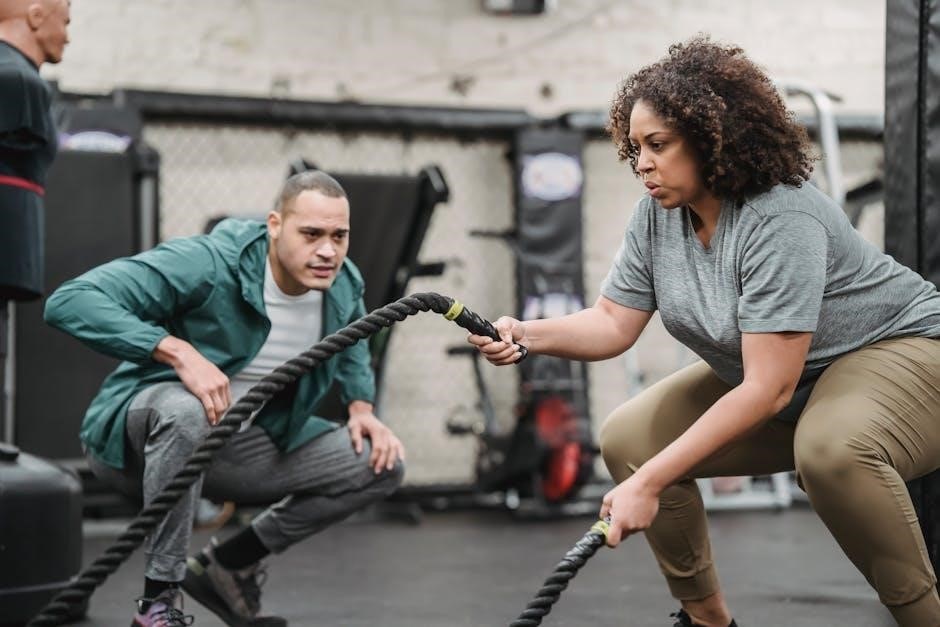
Key Components of a Functional Trainer
A functional trainer typically includes adjustable cables, pulleys, and resistance systems, allowing for versatile movements․ It often features a sturdy frame, multiple attachment points, and variable tension settings․
Understanding the Machine Setup
A functional trainer’s setup typically includes adjustable cables, pulleys, and a weight stack system․ The machine allows users to customize resistance levels and cable positions to target specific muscle groups․ Key components include a sturdy frame, ergonomic handles, and multiple attachment points for versatility․ Understanding how to adjust the cables, select resistance, and position the body properly is essential for effective workouts․ The setup often features a compact design, making it ideal for home or gym use․ Proper alignment and safety features, such as weight stack guards, ensure a secure training environment․ By familiarizing yourself with the machine’s setup, you can maximize its potential and achieve your fitness goals efficiently․
Adjustable Cables and Pulleys
Functional trainers feature adjustable cables and pulleys, allowing users to customize exercises by altering the direction and angle of resistance․ The cables are durable and smooth, providing consistent tension during movements․ Pulleys can be positioned at various heights to target different muscle groups, from chest presses to lat pulldowns․ This versatility enables a wide range of exercises, including unilateral and bilateral movements․ Adjusting the cables and pulleys correctly ensures proper form and maximizes the effectiveness of each exercise․ Whether focusing on strength, hypertrophy, or functional movement, the adaptability of these components makes them a cornerstone of functional training equipment․
Variable Resistance Levels
Functional trainers offer variable resistance levels, enabling users to tailor workouts to their fitness goals․ This feature allows for progressive overload, where resistance can be increased gradually to build strength and muscle․ Lower resistance settings are ideal for rehabilitation or beginners, while higher levels challenge advanced users․ The ability to adjust resistance ensures that exercises remain effective as fitness levels improve․ This adaptability makes functional trainers suitable for a wide range of individuals, from those recovering from injuries to athletes seeking to enhance performance․ By varying resistance, users can achieve balanced muscle development and improve overall functional strength efficiently․
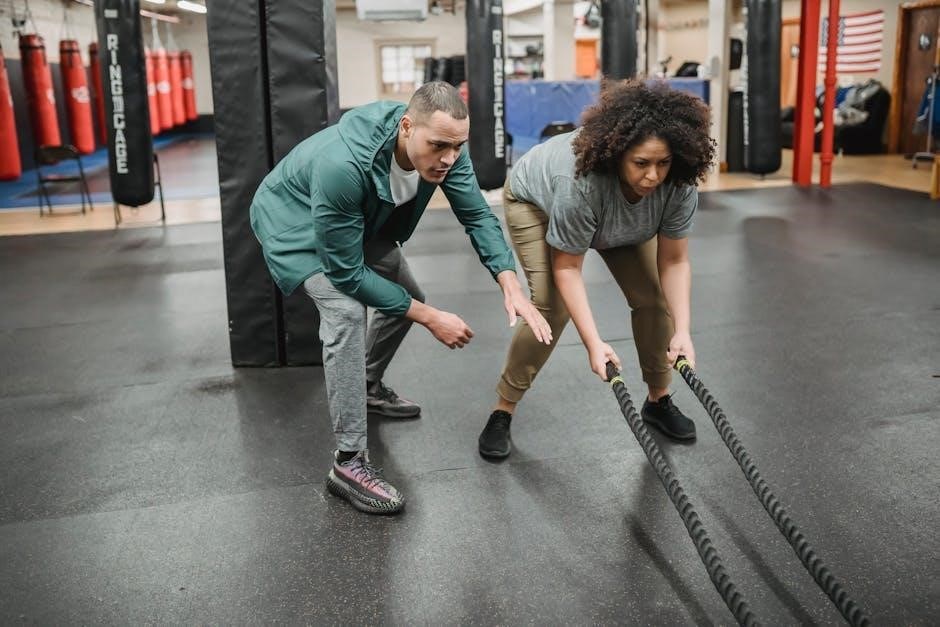
Essential Functional Trainer Exercises
Functional trainer exercises target multiple muscle groups, enhancing strength, coordination, and mobility․ They include presses, pulls, and rotational movements, ideal for improving overall functional fitness and athleticism․
Upper Body Exercises
Functional trainer upper body exercises target the chest, shoulders, and arms, enhancing strength and mobility․ Popular exercises include chest presses, rows, and shoulder presses, which work multiple muscle groups․ Bicep curls and tricep extensions isolate the arms, while lateral raises and wood chops improve shoulder stability and core engagement․ These exercises mimic real-life movements, promoting better posture and functional strength․ They can be performed bilaterally or unilaterally, allowing for balanced development and injury rehabilitation․ Adjusting cable heights and resistance levels offers versatility for different fitness goals․ Whether focusing on hypertrophy or functional fitness, these exercises provide an effective way to build a strong, capable upper body․
Lower Body Exercises
Functional trainer lower body exercises are designed to strengthen the legs, glutes, and hips while improving mobility and stability․ Cable goblet squats and pull-throughs target the quads and glutes, enhancing power and endurance․ Lunges with cable pulls challenge balance and unilateral strength, while step-ups focus on hip drive and coordination․ Leg curls and extensions isolate the hamstrings and quads, aiding in muscle recovery and growth․ These exercises mimic real-life movements, such as climbing stairs or lifting, making them ideal for functional fitness․ Variable resistance levels allow customization for different fitness goals, from rehabilitation to advanced training․ Incorporating these exercises into your routine can improve overall lower body strength and enhance everyday activities․
Core Strengthening Exercises
Core strengthening exercises on a functional trainer are essential for improving stability, balance, and overall functional fitness․ Cable crunches effectively target the abdominal muscles, while standing wood chops and rotational presses enhance rotational strength and core engagement․ Pallof presses are excellent for building anti-rotational strength, crucial for stability․ These exercises mimic real-life movements, such as twisting or lifting, making them highly functional․ Adjustable resistance levels allow customization for different fitness goals, from rehabilitation to advanced training․ Incorporating core exercises into your routine can improve posture, reduce injury risk, and enhance athletic performance․ Functional trainer core workouts are versatile and efficient, making them a key component of any comprehensive fitness plan․
Full-Body Workout Options
A functional trainer is ideal for full-body workouts, allowing you to engage multiple muscle groups simultaneously․ Exercises like cable squats, standing chest presses, and cable deadlifts work the legs, chest, and back in one motion․ Lunges with cable pulls challenge balance and target the lower body and core․Rows and lat pulldowns can be combined with leg movements for a comprehensive upper and lower body workout․ These compound exercises improve coordination, strength, and functional mobility․ By incorporating full-body movements, you can achieve a balanced workout that enhances overall fitness and prepares your body for real-life activities․ The versatility of the functional trainer makes it an excellent tool for efficient and effective full-body training sessions․

Advanced Functional Trainer Workouts
Explosive power exercises, unilateral training, and plyometric movements challenge athletes, enhancing strength and agility․ These workouts target advanced fitness levels, pushing limits for optimal performance and conditioning․
Explosive Power Exercises
Explosive power exercises on a functional trainer are designed to boost speed, strength, and agility․ One effective move is the cable jump squat, where you explosively drive upward using the cables for resistance․ Another is the resisted sprint, which enhances acceleration and power․ Cable box jumps also improve vertical explosiveness․ These exercises target fast-twitch muscle fibers, essential for athletes and those seeking advanced conditioning․ Proper form is crucial to maximize benefits and prevent injury․ Incorporating these into your routine can significantly enhance athletic performance and overall power output, making them a key component of advanced functional training programs․
Unilateral Training Options
Unilateral training on a functional trainer targets one side of the body at a time, improving balance and addressing muscle imbalances․ Exercises like single-arm chest presses and single-arm rows allow focused strength-building․ Single-leg cable deadlifts enhance stability and power, while lateral raises and front raises isolate shoulder muscles․ These exercises promote symmetry, prevent overuse injuries, and enhance overall athleticism․ By working each limb independently, unilateral training ensures equal development and can correct strength disparities․ Incorporating such movements into your routine fosters better coordination and functional strength, making them essential for a well-rounded workout program․
Plyometric Movements
Plyometric movements on a functional trainer add explosive power to your workouts․ These dynamic exercises, like explosive cable presses and rapid pull-aparts, enhance speed and reactivity․ By incorporating plyometrics, you improve neuromuscular coordination and functional fitness․ Exercises such as box jumps with cable assistance or explosive chest presses mimic real-life explosive movements․ They also boost power output and overall athleticism․ For example, rapid alternating curls or high-pulley wood chops can be performed with quick, powerful transitions․ Plyometric training on a functional trainer is versatile and effective for building explosive strength and enhancing sports performance․ It’s a key component of advanced workouts, offering a challenging and engaging way to elevate your fitness level․
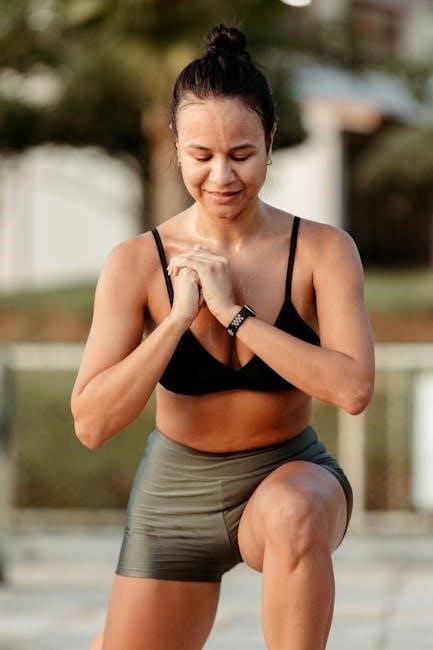
Functional Trainer Exercises for Specific Muscle Groups
A functional trainer targets specific muscles like chest, back, shoulders, legs, and core with exercises such as chest presses, rows, and pull-throughs, ensuring balanced development and strength․
Chest Exercises
A functional trainer is excellent for targeting the chest muscles through various exercises․ The chest press, performed by pushing cables outward, works the pectoralis major․ Incline chest presses focus on the upper chest, while decline presses target the lower chest․ Cable flyes, where cables are pulled outward in a wide arc, engage the pectoralis muscles deeply․ These exercises can be done bilaterally or unilaterally, allowing for balanced development․ Adjusting the cable height and resistance enables customization to fitness levels․ Functional trainers also support explosive movements like cable push presses for added power․ Regular chest workouts on a functional trainer enhance strength, muscle endurance, and overall chest definition, making it a versatile tool for chest-focused training routines․
Back and Shoulder Exercises
A functional trainer is ideal for strengthening the back and shoulders through a variety of exercises․ Lat pulldowns target the latissimus dorsi, while seated rows engage the rhomboids and trapezius muscles․ Cable-based exercises like bent-over rows and single-arm rows allow for targeted muscle activation․ For shoulders, lateral raises, front raises, and rear delt flyes can be performed to build deltoid strength and definition․ Unilateral exercises, such as single-arm lat pulldowns, help identify and address muscle imbalances․ The adjustable cable system enables precise control over movement and resistance, ensuring effective engagement of back and shoulder muscles․ Regularly incorporating these exercises into your routine can improve posture, enhance athletic performance, and contribute to a well-rounded upper body workout․
Leg and Glute Exercises
A functional trainer is highly effective for targeting the legs and glutes through a variety of dynamic exercises․ Cable goblet squats and cable pull-throughs engage the glutes and hamstrings, while step-ups and lunges improve functional strength and balance․ Leg curls and leg extensions can isolate the hamstrings and quads, respectively, for focused development․ The adjustable cable system allows for precise control over movement and resistance, ensuring effective engagement of the lower body muscles․ Incorporating unilateral exercises, like single-leg deadlifts, helps address imbalances and enhances stability․ Regularly performing these exercises can improve overall lower body strength, power, and mobility, making them essential for both athletic performance and everyday functional movements․
Arm and Core Exercises
Functional trainers are excellent for targeting the arms and core with precise, controlled movements․ Bicep curls and tricep extensions effectively isolate the arms, while cable crunches and cable rotations engage the core․ The adjustable cable system allows for varying resistance levels, ensuring comprehensive development․ Standing cable woodchops and chest presses with rotation strengthen the obliques and improve rotational power․ These exercises enhance functional strength, stability, and muscle balance․ Incorporating unilateral movements, like single-arm cable rows, helps address imbalances and boosts overall core stability․ Regularly performing these exercises can improve posture, enhance athletic performance, and support everyday activities․ The versatility of the functional trainer makes it ideal for achieving well-rounded arm and core development․
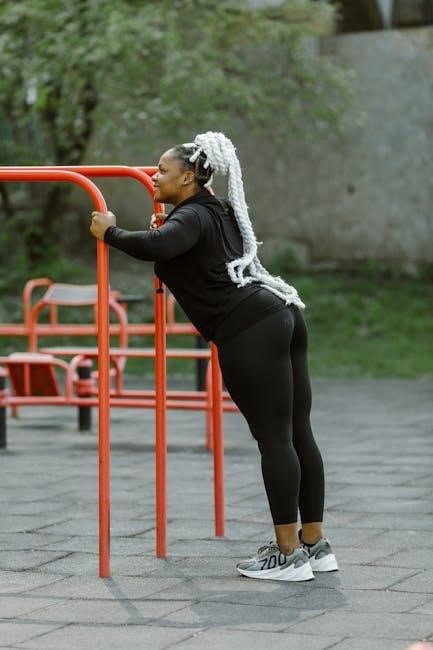
Sample Workout Plans
Discover structured routines for all fitness levels, from full-body workouts to targeted muscle group exercises․ Plans include upper body, lower body, and core-focused sessions with adjustable resistance․
Beginner-Friendly Routine
A beginner-friendly functional trainer routine focuses on foundational movements to build strength and coordination․ Start with 2-3 sets of 10-12 reps for each exercise․ Warm up with 5-10 minutes of light cardio․ Begin with Lat Pulldowns to target the back and shoulders, followed by Seated Rows for a full upper body engagement․ Transition to Chest Press and Shoulder Press for chest and shoulder development․ Include Bicep Curls and Tricep Extensions for arm strength․ Add Cable Crunches for core engagement and finish with Woodchoppers for rotational strength․ Rest for 60-90 seconds between sets and adjust resistance as needed․ Focus on proper form and gradually increase intensity․ This routine provides a balanced workout for newcomers, promoting overall fitness and muscle endurance․ Consistency is key to seeing progress and building a strong foundation․
Intermediate Training Program
An intermediate functional trainer program builds on foundational strength with more complex movements and increased intensity․ Aim for 3-4 sets of 8-12 reps per exercise․ Start with Low-Handle Cable Goblet Squats for lower body engagement, followed by Cable Pull-Throughs to target glutes and hamstrings․ Transition to upper body with Single-Arm Rows and Chest Press with Rotation for improved stability․ Incorporate Standing Cable Woodchoppers for core strength and Lat Pulldowns for back development․ Add Superset Cable Bicep Curls and Overhead Tricep Extensions for efficient arm training․ Finish with Cable Lateral Raises and Crossover Rear Flyes for shoulder mobility․ Rest for 60-90 seconds between sets and gradually increase resistance or volume․ This program enhances functional strength and promotes muscle balance, preparing you for advanced workouts․ Consistency and proper form are key to progression․
Advanced Full-Body Workout
An advanced full-body workout with a functional trainer focuses on explosive power and unilateral training․ Begin with Single-Leg Deadlifts with Cable Pull to enhance balance and strength․ Follow with Plyometric Push Presses for explosive upper body power․ Incorporate Rapid-Alternating Cable Presses to challenge coordination and endurance․ Transition to Multi-Planar Rows for comprehensive back and core engagement․ Add Cable Step-Ups with Rotation to target legs, core, and mobility․ Finish with High-Intensity Interval Training (HIIT) using Cable Sprints and Woodchoppers for a cardio blast․ Rest minimally between sets (30-60 seconds) and aim for 4-5 sets per exercise․ This program builds functional strength, improves coordination, and boosts overall fitness․ Progress by increasing resistance, speed, or volume, ensuring proper form to avoid injury․ This advanced routine is ideal for those seeking a challenging, dynamic workout․ Consistency is key to achieving results․
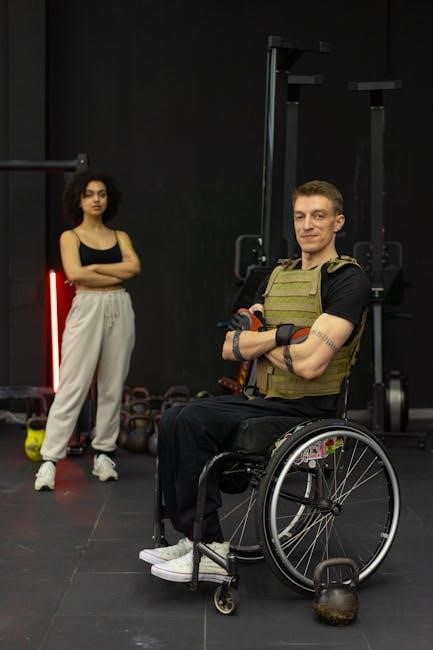
Tips for Maximizing Your Functional Trainer Workouts
Focus on proper form, vary exercises, and incorporate progressive overload․ Mix unilateral and bilateral movements, and add cardio elements for a balanced, efficient workout routine․
Proper Form and Technique
Maintaining proper form is crucial for effective and injury-free workouts․ Start with a stable stance and engage your core to maintain balance․ Ensure smooth, controlled movements throughout each exercise, avoiding jerky motions․ Focus on full range of motion to maximize muscle engagement․ For cable exercises, keep the cable at the appropriate height and distance to target the intended muscle groups․ Practice each movement slowly to build muscle memory and prevent poor habits․ Regularly review your technique to make adjustments and ensure optimal results․ Proper form not only enhances the effectiveness of your workout but also reduces the risk of injury, making your training safer and more productive․
Progressive Overload Strategies
Progressive overload is key to continuous strength gains․ Gradually increase resistance by adjusting cable tension or weight․ Aim to add 2․5-5lbs weekly․ Incorporate more reps or sets over time; Reduce rest periods between sets to challenge endurance․ Use tempo training to slow down movements, enhancing muscle tension․ Alternate between unilateral and bilateral exercises to target muscle imbalances․ Periodically change grip or stance to vary muscle engagement․ Track progress in a workout log to monitor improvements․ Consistently challenging muscles leads to hypertrophy and strength advancements․ Stay committed to progressive overload to achieve long-term fitness goals effectively․ This approach ensures sustained growth and keeps workouts engaging and productive․
Incorporating Cardio Elements
Incorporate cardio into functional trainer workouts by using supersets or circuits to minimize rest․ Perform high-intensity interval training (HIIT) with short bursts of explosive movements․ Try cable jabs, rapid rows, or squat-to-presses to elevate heart rate․ Add dynamic exercises like cable rotations or lateral pulls to engage multiple muscle groups while increasing cardiovascular effort․ Use lighter resistance with faster tempos to simulate aerobic exercises․ Combine upper and lower body movements for a full-body cardio challenge․ Track heart rate to ensure it stays within target zones․ This approach enhances endurance, burns calories, and improves coordination․ Blend strength and cardio for a well-rounded, efficient workout that boosts overall fitness and metabolism․ This method keeps sessions engaging while maximizing time and energy․
Functional trainer exercises are effective for improving strength, mobility, and overall fitness․ Consistency and proper form yield the best results․ Start your journey today and embrace the benefits!
Final Thoughts on Functional Trainer Exercises
Functional trainer exercises are a versatile and effective way to enhance strength, mobility, and overall fitness․ They cater to all fitness levels, from beginners to advanced athletes, offering a wide range of movements that mimic daily activities․ By incorporating exercises like chest presses, rows, squats, and core-strengthening movements, individuals can improve coordination, balance, and functional strength․ The ability to target specific muscle groups or perform full-body workouts makes functional trainers ideal for personalized fitness goals․ Consistency and proper form are key to maximizing results․ Whether aiming to build muscle, boost endurance, or improve mobility, functional trainer exercises provide a comprehensive approach to achieving a healthier, more resilient body․ Start your journey today and experience the transformative benefits of functional training!
Encouragement to Start Your Journey
Embarking on a functional trainer journey is an exciting step toward improving your overall fitness and well-being․ Whether you’re a beginner or looking to elevate your routine, functional trainers offer a versatile and efficient way to achieve your goals․ With their ability to target multiple muscle groups and enhance functional strength, these machines empower you to move better, feel stronger, and embrace a healthier lifestyle․ Don’t hesitate to start—every rep and set brings you closer to a more resilient and capable body․ Begin with simple exercises, progress at your own pace, and celebrate small victories along the way․ Your fitness journey is a personal and rewarding path, and a functional trainer is a powerful tool to help you succeed․ Start today and transform your fitness forever!